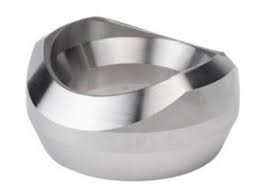Stainless Steel Threaded Outlets are one of the most widely used branch connection fittings in modern piping systems. These high-performance fittings are specifically designed to create a secure branch connection from a larger header pipe to a smaller branch pipe without welding the entire circumference. Threaded outlets, also referred to as Threaded Olets, provide an economical and efficient way to make 90-degree pipe branches with maximum leak-tightness and structural integrity. Due to their design, threaded outlets are easy to install, highly durable, and require minimal maintenance, making them an ideal choice for industries where precision, safety, and reliability are paramount.
Design and Function of Stainless Steel Threaded Outlets
A threaded outlet is a self-reinforced branch fitting with an internal female thread, designed to connect directly to a threaded pipe. It is typically welded onto the run pipe (header) and provides a threaded connection for the branch pipe. The connection is made without full penetration welding, which reduces fabrication time and cost.
Key features include:
- Easy Installation: No special tools required; simple threading ensures quick assembly.
- Leak-Tight Connection: High-quality threads maintain pressure integrity.
- Space-Saving Design: Compact dimensions suitable for confined installations.
- Cost-Effective Solution: Eliminates the need for complex welding procedures.
Types of Stainless Steel Threaded Outlets
Depending on the size, shape, and angle of the branch connection, threaded outlets are available in several types, including:
- 90° Threaded Outlet – Most common design for standard branch connections.
- 45° Threaded Outlet – Used where a 45-degree branch connection is required.
- Lateral Threaded Outlet – Provides a branch connection at an angle other than 90° or 45°.
- Sweepolet® – A contoured, integrally reinforced outlet for lower stress concentration.
- Elbolet® – Designed for 90° connections from elbows or curved pipe sections.
Each type ensures smooth flow transition while maintaining the structural strength of the main pipe.
Materials and Grades for Stainless Steel Threaded Outlets
Stainless steel threaded outlets are manufactured in a wide range of materials and grades to meet diverse industry needs. Common materials include:
- Austenitic Stainless Steels – SS 304, 304L, 316, 316L, 321, 347
- Ferritic Stainless Steels – SS 409, 410, 430
- Martensitic Stainless Steels – SS 420, 431
- Duplex and Super Duplex Stainless Steels – UNS S31803, S32205, S32750, S32760
- Precipitation-Hardening Stainless Steels – 17-4PH (UNS S17400)
These grades provide varying levels of corrosion resistance, strength, and performance in aggressive or high-temperature environments.
Special alloys like Alloy 20, Incoloy 800/825, Monel 400/K500, and Hastelloy C22/C276 are also available for highly corrosive or demanding applications.
Standards and Specifications
Threaded outlets are manufactured in compliance with industry standards to ensure compatibility and reliability. Common standards include:
- ASME B16.11 – Forged fittings, socket-welding, and threaded
- MSS SP-97 – Integrally reinforced branch outlet fittings
- ANSI/ASME B1.20.1 – Pipe threads, general purpose (inch)
- BS, DIN, and ISO standards – International equivalents
Manufacturers offer threaded outlets in pressure classes ranging from 3000#, 6000#, and 9000# for different piping requirements.
Advantages of Using Stainless Steel Threaded Outlets
- High Corrosion Resistance – Suitable for harsh industrial and marine environments.
- Ease of Installation – Eliminates the need for full circumferential welds.
- Versatile Applications – Compatible with a wide range of pipe sizes and systems.
- Durability and Strength – Withstand high pressure and temperature variations.
- Reduced Downtime – Faster assembly minimizes maintenance and operational interruptions.
Applications of Stainless Steel Threaded Outlets
- Stainless Steel Threaded Outlets are used in numerous industries where reliable branch connections are critical:
- Oil & Gas Pipelines – Safe and secure branch lines for upstream and downstream operations.
- Chemical & Petrochemical Plants – Resistant to corrosive chemicals and high-pressure fluids.
- Power Generation – Durable connections for steam and condensate lines.
- Water Treatment Facilities – Long-lasting connections for high-volume fluid handling.
- Pharmaceutical & Food Industries – Hygienic and contamination-free piping systems.
- Marine & Offshore Engineering – Resilient in saline and high-humidity environments.
